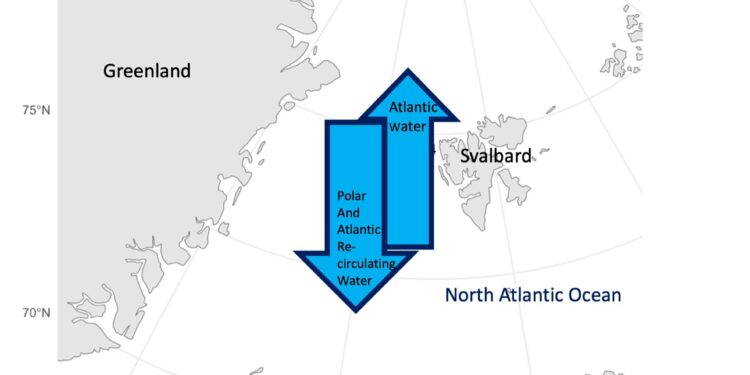PFAS move back and forth between the Arctic and Atlantic oceans at roughly equal rates. Credit: Adapted from Environmental Science & Technology Letters 2024, DOI: 10.1021/acs.estlett.3c00835
The frigid Arctic Ocean is far away from where most people live, but even so, “forever chemicals” reach this remote landscape. Now, research in Letters on environmental science and technology suggests that per- and polyfluoroalkyl substances (PFAS) will not stay there indefinitely. Instead, they are transported in a feedback loop, with the Arctic Ocean potentially exporting as much PFAS to the North Atlantic Ocean as it receives, circulating the compounds around the world.
To reach the Arctic Ocean, some PFAS hitch a ride through the air and fall to the ocean surface, but others enter through adjacent oceans. The potential impact of these compounds on marine organisms depends on which PFAS are present and their quantity, which constantly changes as water flows between the Arctic Ocean and the North Atlantic Ocean.
These bodies of water are connected by the Fram Strait, which is located in northeast Greenland, near the Svalbard archipelago. Warm water moves northward on the east side of the strait, and cold water flows southward along the west side, providing a dynamic gateway for PFAS transport.
Rainer Lohmann and his colleagues wanted to track the movement of PFAS in this region and identify how water circulation influences the mix of contaminants in the Arctic Ocean. The researchers deployed passive sampling systems, which captured PFAS in a microporous membrane filled with absorbent from flowing water. They installed the systems at three locations in Fram Strait and at four depths in each location. After a year, the team recovered the systems and measured the collected PFAS using liquid chromatography and mass spectrometry.
The researchers highlighted that:
- Ten PFAS were detected in at least one passive sampler, but a substance detected in the area by previous search teams was not among them.
- Two compounds called PFOA and PFOS, which are gradually eliminated, were present at the highest levels. Newer, short-chain PFAS were also regularly present.
- Surprisingly, several PFAS have been found in waters less than 3,000 feet deep. The team suggests that these compounds could have achieved this by attaching to particles as they fell to the seafloor.
The team calculated the amounts of PFAS flowing in each direction across the Fram Strait. Their data showed that in one year, about 123 tons were dumped into the Arctic Ocean and about 110 tons into the Atlantic Ocean. According to the researchers, these values are the highest among all pollutants reported in the strait, demonstrating the importance of the back-and-forth circulation of PFAS in the Arctic Ocean.
More information:
Passive sampler-derived profiles and mass fluxes of perfluorinated alkyl substances (PFAS) across the Fram Strait in the North Atlantic, Letters on environmental science and technology (2024). DOI: 10.1021/acs.estlett.3c00835
Provided by the American Chemical Society
Quote: PFAS circulate equally between the Arctic Ocean and the Atlantic Ocean, according to a study (January 10, 2024) retrieved January 10, 2024 from
This document is subject to copyright. Apart from fair use for private study or research purposes, no part may be reproduced without written permission. The content is provided for information only.



